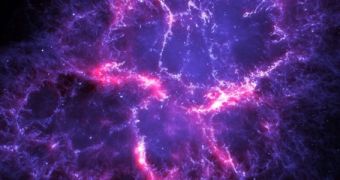The observation powers of the world's most complex and capable space observatories was recently combined to capture this breathtaking view of the Crab Nebula, which is the remnant of a supernova blast that was recorded by ancient Chinese astronomers, in 1054.
The photo was created by combining data collected by the European Space Agency's (ESA) Herschel Space Observatory and the NASA/ESA Hubble Space Telescope. Together, they were able to make out the wispy and delicate filaments of cosmic gas and dust in the massive, expanding cloud.
For this collaboration, Hubble used its visible wavelength capabilities, with three filters dedicated to observing the emissions of oxygen and sulfur ions. Data from NASA's flagship telescope appear in blue in this image. Herschel used its far-infrared sensors to detect dust in the nebulae, shown here in red.
The ESA telescope's Photoconductor Array Camera and Spectrometer (PACS) instrument collected IR data at a wavelength of 70 microns. This information was then combined with archival data from Hubble's now-decommissioned Wide Field and Planetary Camera 2 (WFPC2) instrument to create this all-star view of the Crab Nebula.

 14 DAY TRIAL //
14 DAY TRIAL //